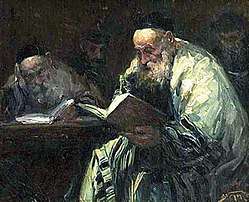Midrash Vayosha
Midrash Vayosha (Hebrew: מדרש ויושע) is an 11th-century CE[1] midrash, one of the smaller midrashim. It is based on Exodus 14:30-15:18. It is an exposition in the style of the later aggadah, and seems to have been intended for Shabbat Shirah or for the seventh day of Passover.
| Rabbinic literature | ||||||||||||
|---|---|---|---|---|---|---|---|---|---|---|---|---|
 Talmud Readers by Adolf Behrman | ||||||||||||
| Talmudic literature | ||||||||||||
|
||||||||||||
| Halakhic Midrash | ||||||||||||
|
||||||||||||
| Aggadic Midrash | ||||||||||||
|
||||||||||||
| Targum | ||||||||||||
|
||||||||||||
Sources
Entire sections of Midrash Vayosha are taken verbatim from the Tanhuma, such as the passage on Exodus 15:3[2] and on 15:5.[3] The story in the exposition of Exodus 14:30, concerning Satan, who appeared before Abraham and Isaac as they went to the sacrifice, may be compared with similar stories in several other works of midrash.[4] The midrash on Exodus 15:2,7 also contains extracts from the Chronicle of Moses; the passage on Usa, the genius of Egypt, agreeing word for word with the excerpt in Yalkut Shimoni § 241. Here the first edition has merely "Midrash," while other editions give the Midrash Abkir as the source, although it is doubtful whether this aggadah ever occurred in that work.
Contents
The sections begin for the most part with the words "ameru hachamim," though Rabbi Joshua ben Levi and Rabbi Samuel b. Naḥmani are occasionally given as the authors.
In the exposition of Exodus 15:18 on the sorrows and the redemption in the Messianic time, the terrible figure of King Armilus is described, and it is said that he will slay the Messiah son of Joseph, but will himself be slain by the Messiah who is the son of David;[5] God will then gather together the scattered remnant of Israel and hold the final judgment; and the wonderful beauty of a new world full of joy and happiness is revealed.
Editions
The midrash was first published at Constantinople in 1519,[6] and has been reprinted by A. Jellinek.[7]
References
- Journal of Jewish art - Volume 10 - Page 8 Universiṭah ha-ʻIvrit bi-Yerushalayim. Merkaz le-omanut Yehudit - 1984 "According to the eleventh-century Midrash Vayosha', 19 Pharaoh was taken down by the Archangel Gabriel to the ..."
- From Tanhuma, Bo
- From Tanhuma, Hukkat, beginning
- See Tanhuma, Vayera, ed. Stettin, No. 24; Yalkut Shimoni, Exodus §§ 98-99, end; and Sefer ha-Yashar, end of pericope "Vayera."
- Compare Sukkah 52a
- Metz, 1849, and elsewhere
- Bet. Ha.Midrash i. 35-57, Jerusalem 1967, 3rd Ed.
![]()